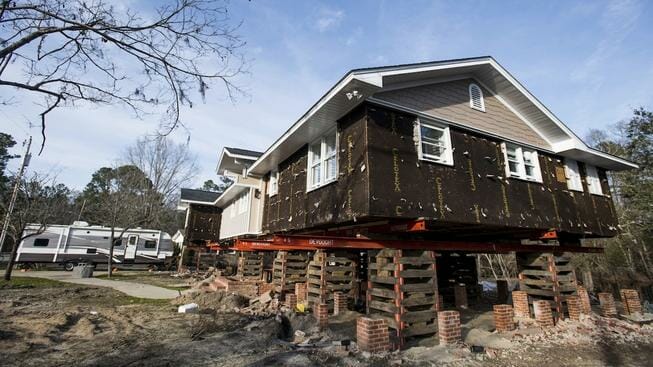

Photo: A travel camper sits in the driveway outside of a home in the process of being raised after being damaged by floodwaters from Hurricane Florence Friday, Feb. 1, 2019, in Conway, S.C. Multiple residents in the neighborhood near the Crabtree Swamp are currently living in campers as their homes are repaired.
When he took the job 15 years ago, Horry County Emergency Manager Randy Webster figured his biggest disasters would be wind and surge rolling over his county’s beaches, South Carolina’s top tourist destination.
Instead, his worries have shifted inland, where rivers overflowing their banks have caused two massive floods in three years.
"We’re getting into this sort of unknown territory," Webster said. "We typically in emergency management have some point of reference to work with. Two floods like this — it’s unheard of."
Scientists say the Earth’s warming climate means more heavy rainfall over short periods of time, and that translates to larger, more ferocious storms on the scale of 2017’s Hurricane Harvey in Texas or 2018’s Hurricane Florence in the Carolinas. Florence dumped six months’ worth of rain on the Carolinas in the course of just a few days.
The growing realization that such events are going to become more common as the result of global warming is forcing Webster and other state officials to revisit how they prepare for and respond to natural disasters.
Late last year, Republican Gov. Henry McMaster created the South Carolina Floodwater Commission to figure out how […]
Full article: Storm-Lashed South Carolina Reassesses Global Warming
A sewage spill polluted oyster beds in South Carolina town
Controversial groundwater withdrawal sparks question of who owns South Carolina water
Clean water is essential for life, yet millions of Americans unknowingly consume contaminants through their…
Human brains contain higher concentrations of microplastics than other organs, according to a new study, and the…
From the Office of the Governor: In anticipation of a multi-day, significant atmospheric river in Northern California,…
From Governor Newsom: Scientists, water managers, state leaders, and experts throughout the state are calling…
Photo: A harmful algal bloom in Milford Lake, Kansas, made the water appear bright green.…
An expanded plastic foam coffee cup is at a donut shop in Monterey Park, California.…